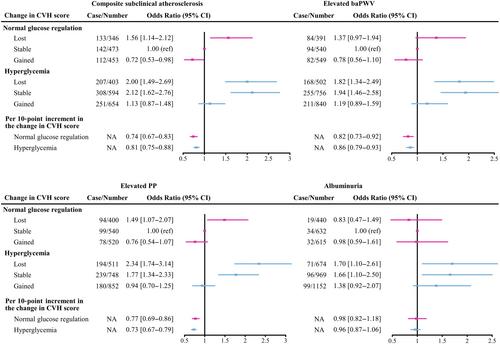The association of ideal cardiovascular health and its change with subclinical atherosclerosis according to glucose status: A prospective cohort study
Abstract
Background
An updated definition was developed to better evaluate cardiovascular health (CVH). We aimed to investigate whether optimal or improvement of six CVH metrics defined by new Life's Essential 8 (LE8) may counteract the risk of subclinical atherosclerosis among patients with hyperglycemia.
Methods
We conducted a prospective analysis of 5225 participants without prior cardiovascular diseases, of whom 4768 had complete data on CVH change. Subjects with CVH scores of 0–49, 50–79, and 80–100 points were categorized as having low, moderate, or high CVH, respectively. Subclinical atherosclerosis was evaluated by brachial-ankle pulse wave velocity, pulse pressure and albuminuria, both separately and in combination.
Results
Of the 5225 participants, 1937 (37.1%) had normal glucose regulation, while 3288 (62.9%) had hyperglycemia. The multivariable-adjusted odds ratio (OR) for composite subclinical atherosclerosis was 2.34 (95% confidence interval [CI], 1.88–2.91), 1.43 (95% CI, 1.21–1.70), and 0.74 (95% CI, 0.46–1.18), for participants with hyperglycemia who had low, moderate, or high overall CVH scores, respectively, compared with participants with normal glucose regulation. In addition, compared with those with stable CVH and normal glucose regulation, participants who exhibited greater improvements in overall CVH from 2010 to 2014 had a reduced risk of composite subclinical atherosclerosis with an OR of 0.72 (95% CI, 0.53–0.98) for those with normal glucose regulation, and 1.13 (95% CI, 0.87–1.48) for those with hyperglycemia.
Conclusions
The novel defined CVH using six metrics was inversely associated with subsequent risk of subclinical atherosclerosis. Both the status of CVH and its changes modified the relationship between hyperglycemia and subclinical atherosclerosis.


 求助内容:
求助内容: 应助结果提醒方式:
应助结果提醒方式:


